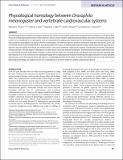Physiological homology between Drosophila melanogaster and vertebrate cardiovascular systems
Author(s)
Choma, Michael A.; Suter, Melissa J.; Vakoc, Benjamin; Bouma, Brett E.; Tearney, Guillermo J.
DownloadChoma-2011-Physiological homology between Drosophila.pdf (3.125Mb)
PUBLISHER_CC
Publisher with Creative Commons License
Creative Commons Attribution
Terms of use
Metadata
Show full item recordAbstract
The physiology of the Drosophila melanogaster cardiovascular system remains poorly characterized compared with its vertebrate counterparts. Basic measures of physiological performance remain unknown. It also is unclear whether subtle physiological defects observed in the human cardiovascular system can be reproduced in D. melanogaster. Here we characterize the cardiovascular physiology of D. melanogaster in its pre-pupal stage by using high-speed dye angiography and optical coherence tomography. The heart has vigorous pulsatile contractions that drive intracardiac, aortic and extracellular-extravascular hemolymph flow. Several physiological measures, including weight-adjusted cardiac output, body-length-adjusted aortic velocities and intracardiac shear forces, are similar to those in the closed vertebrate cardiovascular systems, including that of humans. Extracellular-extravascular flow in the pre-pupal D. melanogaster circulation drives convection-limited fluid transport. To demonstrate homology in heart dysfunction, we showed that, at the pre-pupal stage, a troponin I mutant, held-up2 (hdp2), has impaired systolic and diastolic heart wall velocities. Impaired heart wall velocities occur in the context of a non-dilated phenotype with a mildly depressed fractional shortening. We additionally derive receiver operating characteristic curves showing that heart wall velocity is a potentially powerful discriminator of systolic heart dysfunction. Our results demonstrate physiological homology and support the use of D. melanogaster as an animal model of complex cardiovascular disease.
Date issued
2010-12Department
Harvard University--MIT Division of Health Sciences and TechnologyJournal
Disease Models and Mechanisms
Publisher
Company of Biologists Ltd.
Citation
Choma, M. A. et al. “Physiological Homology Between Drosophila Melanogaster and Vertebrate Cardiovascular Systems.” Disease Models & Mechanisms 4.3 (2010): 411–420. Web.
Version: Final published version
ISSN
1754-8403
1754-8411